Business Environment Analysis Report: Nestle, NHS, Oxfam - Semester 2
VerifiedAdded on 2020/06/06
|11
|3407
|59
Report
AI Summary
This report provides a detailed analysis of the business environment, focusing on three different types of organizations: Nestle (private), NHS (public), and Oxfam (voluntary). The report examines the interrelationship between various organizational functions, such as human resources, finance, marketing, and production, and their relation to the organizations' objectives. It also explores the positive and negative impacts of the macro-environment, including political, economic, social, technological, legal, and environmental factors, on business operations. A SWOT analysis is conducted to identify the strengths, weaknesses, opportunities, and threats for Nestle. Furthermore, the report investigates the interrelation between internal and external factors affecting the organizations. The study also covers the different types, scopes, and sizes of these businesses, and their organizational structures.
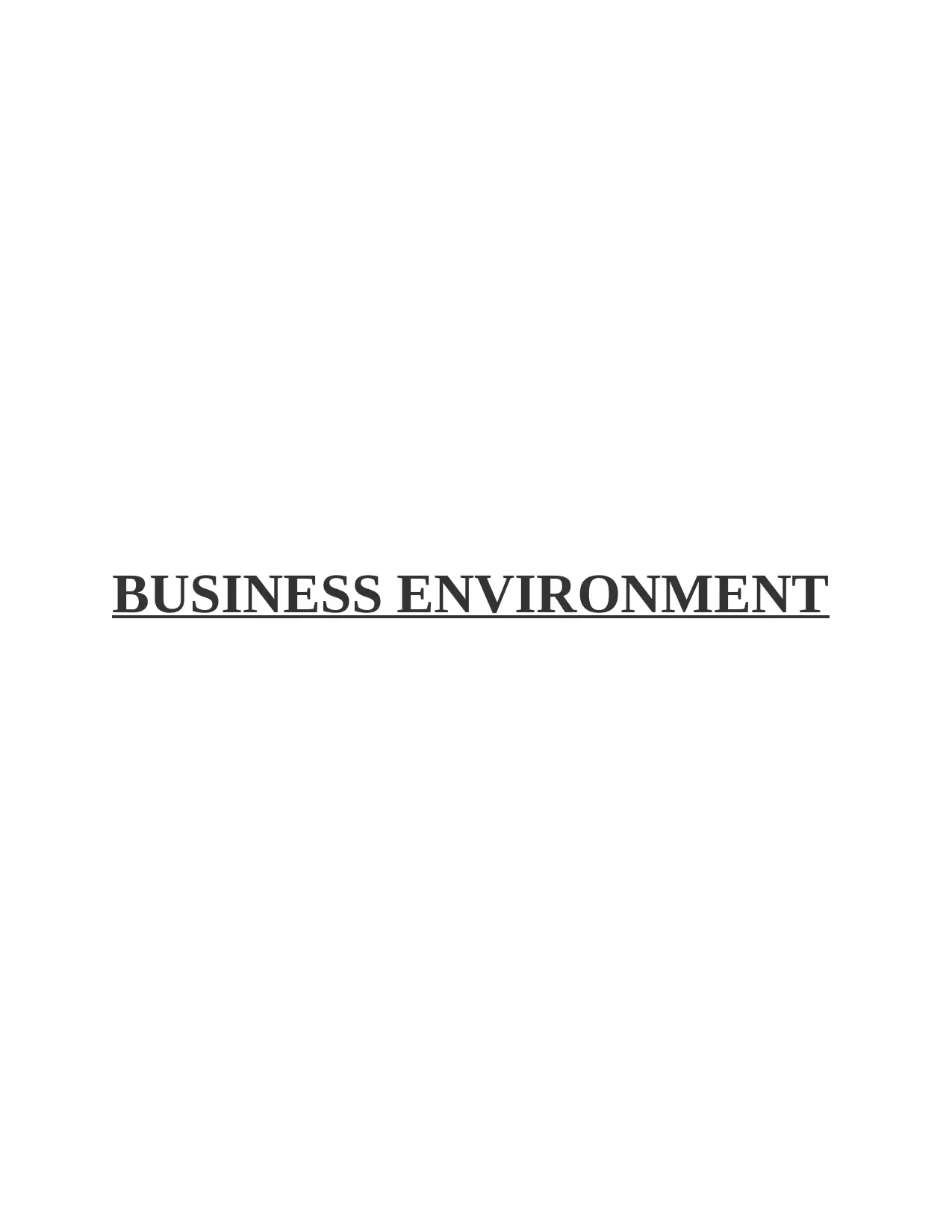
BUSINESS ENVIRONMENT
Paraphrase This Document
Need a fresh take? Get an instant paraphrase of this document with our AI Paraphraser
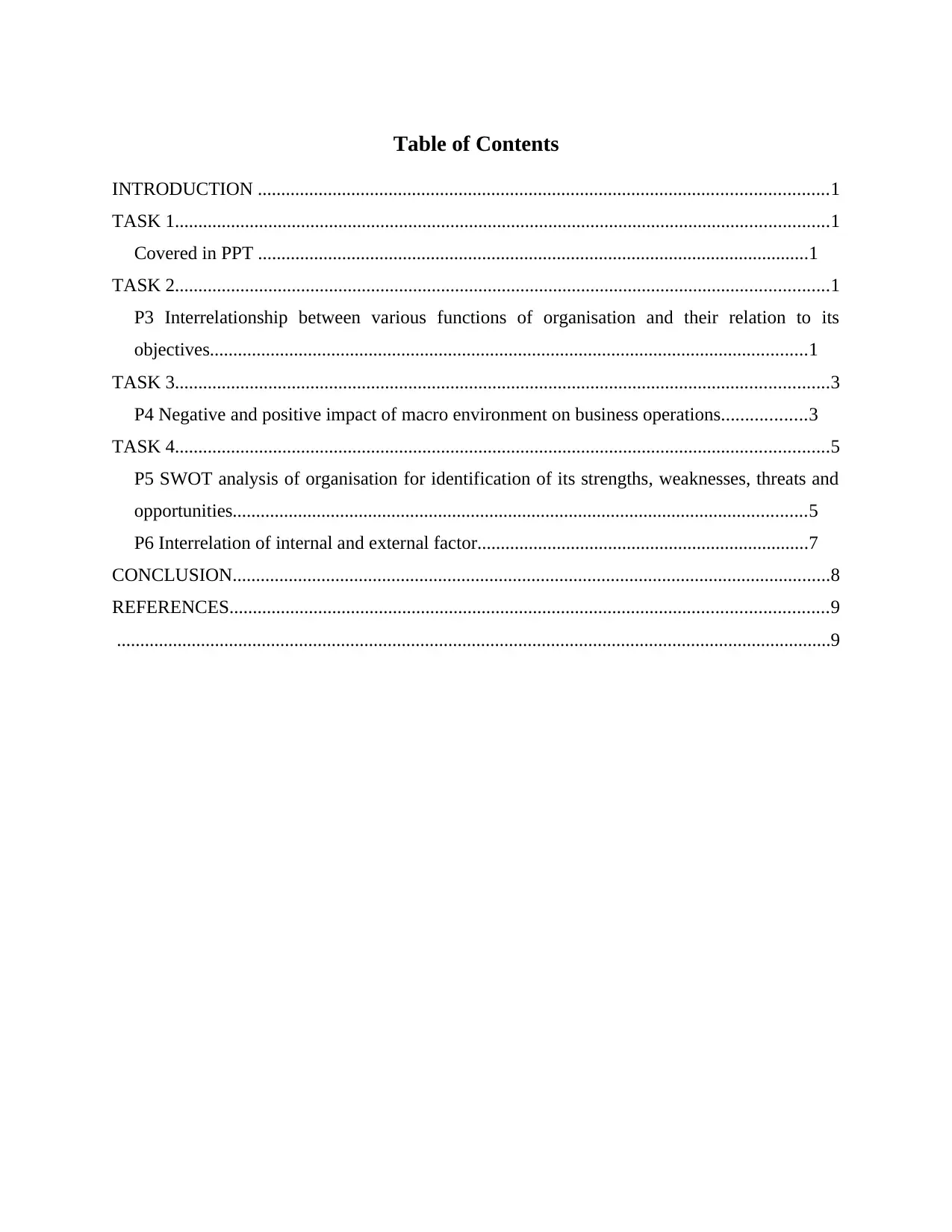
Table of Contents
INTRODUCTION ..........................................................................................................................1
TASK 1............................................................................................................................................1
Covered in PPT ......................................................................................................................1
TASK 2............................................................................................................................................1
P3 Interrelationship between various functions of organisation and their relation to its
objectives................................................................................................................................1
TASK 3............................................................................................................................................3
P4 Negative and positive impact of macro environment on business operations..................3
TASK 4............................................................................................................................................5
P5 SWOT analysis of organisation for identification of its strengths, weaknesses, threats and
opportunities...........................................................................................................................5
P6 Interrelation of internal and external factor.......................................................................7
CONCLUSION................................................................................................................................8
REFERENCES................................................................................................................................9
.........................................................................................................................................................9
INTRODUCTION ..........................................................................................................................1
TASK 1............................................................................................................................................1
Covered in PPT ......................................................................................................................1
TASK 2............................................................................................................................................1
P3 Interrelationship between various functions of organisation and their relation to its
objectives................................................................................................................................1
TASK 3............................................................................................................................................3
P4 Negative and positive impact of macro environment on business operations..................3
TASK 4............................................................................................................................................5
P5 SWOT analysis of organisation for identification of its strengths, weaknesses, threats and
opportunities...........................................................................................................................5
P6 Interrelation of internal and external factor.......................................................................7
CONCLUSION................................................................................................................................8
REFERENCES................................................................................................................................9
.........................................................................................................................................................9
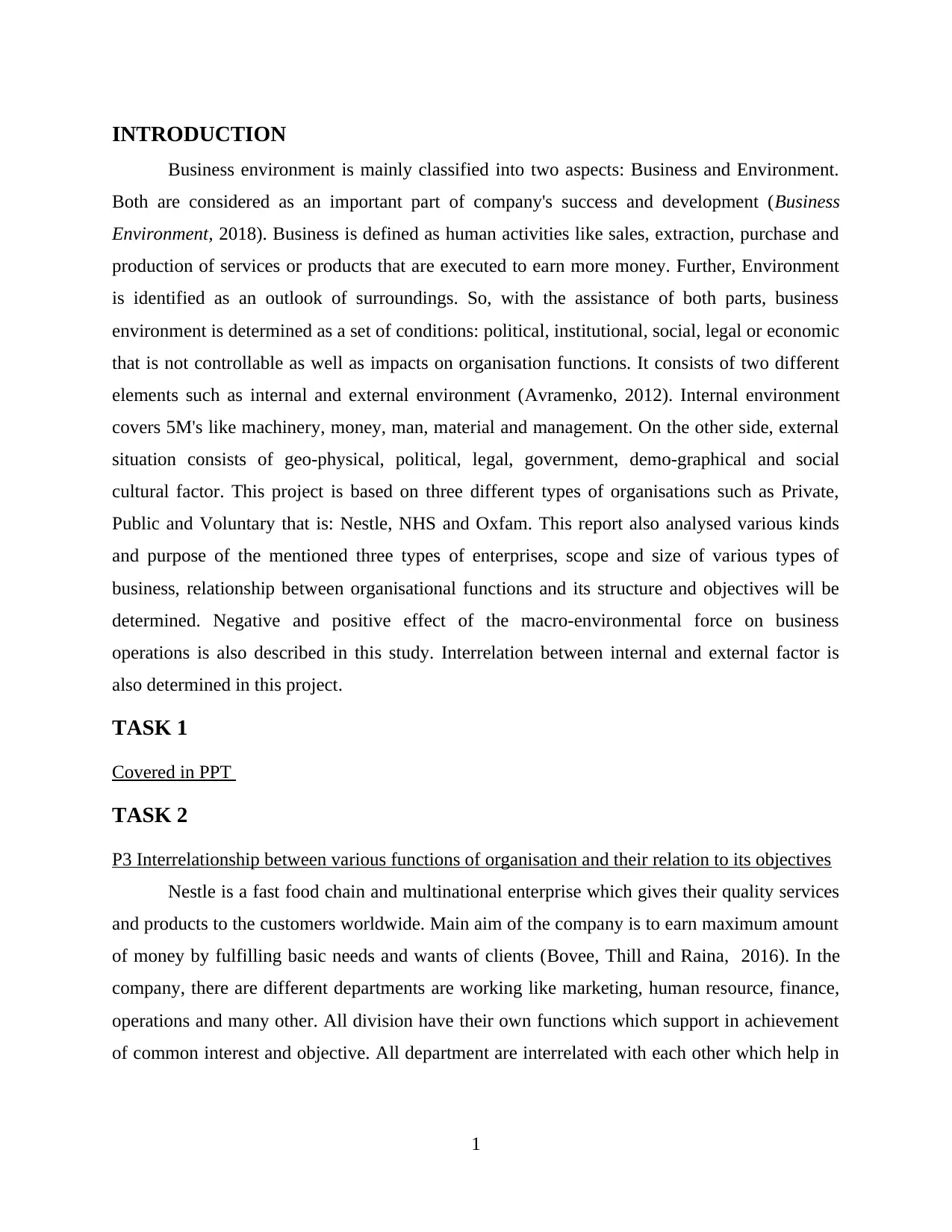
INTRODUCTION
Business environment is mainly classified into two aspects: Business and Environment.
Both are considered as an important part of company's success and development (Business
Environment, 2018). Business is defined as human activities like sales, extraction, purchase and
production of services or products that are executed to earn more money. Further, Environment
is identified as an outlook of surroundings. So, with the assistance of both parts, business
environment is determined as a set of conditions: political, institutional, social, legal or economic
that is not controllable as well as impacts on organisation functions. It consists of two different
elements such as internal and external environment (Avramenko, 2012). Internal environment
covers 5M's like machinery, money, man, material and management. On the other side, external
situation consists of geo-physical, political, legal, government, demo-graphical and social
cultural factor. This project is based on three different types of organisations such as Private,
Public and Voluntary that is: Nestle, NHS and Oxfam. This report also analysed various kinds
and purpose of the mentioned three types of enterprises, scope and size of various types of
business, relationship between organisational functions and its structure and objectives will be
determined. Negative and positive effect of the macro-environmental force on business
operations is also described in this study. Interrelation between internal and external factor is
also determined in this project.
TASK 1
Covered in PPT
TASK 2
P3 Interrelationship between various functions of organisation and their relation to its objectives
Nestle is a fast food chain and multinational enterprise which gives their quality services
and products to the customers worldwide. Main aim of the company is to earn maximum amount
of money by fulfilling basic needs and wants of clients (Bovee, Thill and Raina, 2016). In the
company, there are different departments are working like marketing, human resource, finance,
operations and many other. All division have their own functions which support in achievement
of common interest and objective. All department are interrelated with each other which help in
1
Business environment is mainly classified into two aspects: Business and Environment.
Both are considered as an important part of company's success and development (Business
Environment, 2018). Business is defined as human activities like sales, extraction, purchase and
production of services or products that are executed to earn more money. Further, Environment
is identified as an outlook of surroundings. So, with the assistance of both parts, business
environment is determined as a set of conditions: political, institutional, social, legal or economic
that is not controllable as well as impacts on organisation functions. It consists of two different
elements such as internal and external environment (Avramenko, 2012). Internal environment
covers 5M's like machinery, money, man, material and management. On the other side, external
situation consists of geo-physical, political, legal, government, demo-graphical and social
cultural factor. This project is based on three different types of organisations such as Private,
Public and Voluntary that is: Nestle, NHS and Oxfam. This report also analysed various kinds
and purpose of the mentioned three types of enterprises, scope and size of various types of
business, relationship between organisational functions and its structure and objectives will be
determined. Negative and positive effect of the macro-environmental force on business
operations is also described in this study. Interrelation between internal and external factor is
also determined in this project.
TASK 1
Covered in PPT
TASK 2
P3 Interrelationship between various functions of organisation and their relation to its objectives
Nestle is a fast food chain and multinational enterprise which gives their quality services
and products to the customers worldwide. Main aim of the company is to earn maximum amount
of money by fulfilling basic needs and wants of clients (Bovee, Thill and Raina, 2016). In the
company, there are different departments are working like marketing, human resource, finance,
operations and many other. All division have their own functions which support in achievement
of common interest and objective. All department are interrelated with each other which help in
1
⊘ This is a preview!⊘
Do you want full access?
Subscribe today to unlock all pages.

Trusted by 1+ million students worldwide
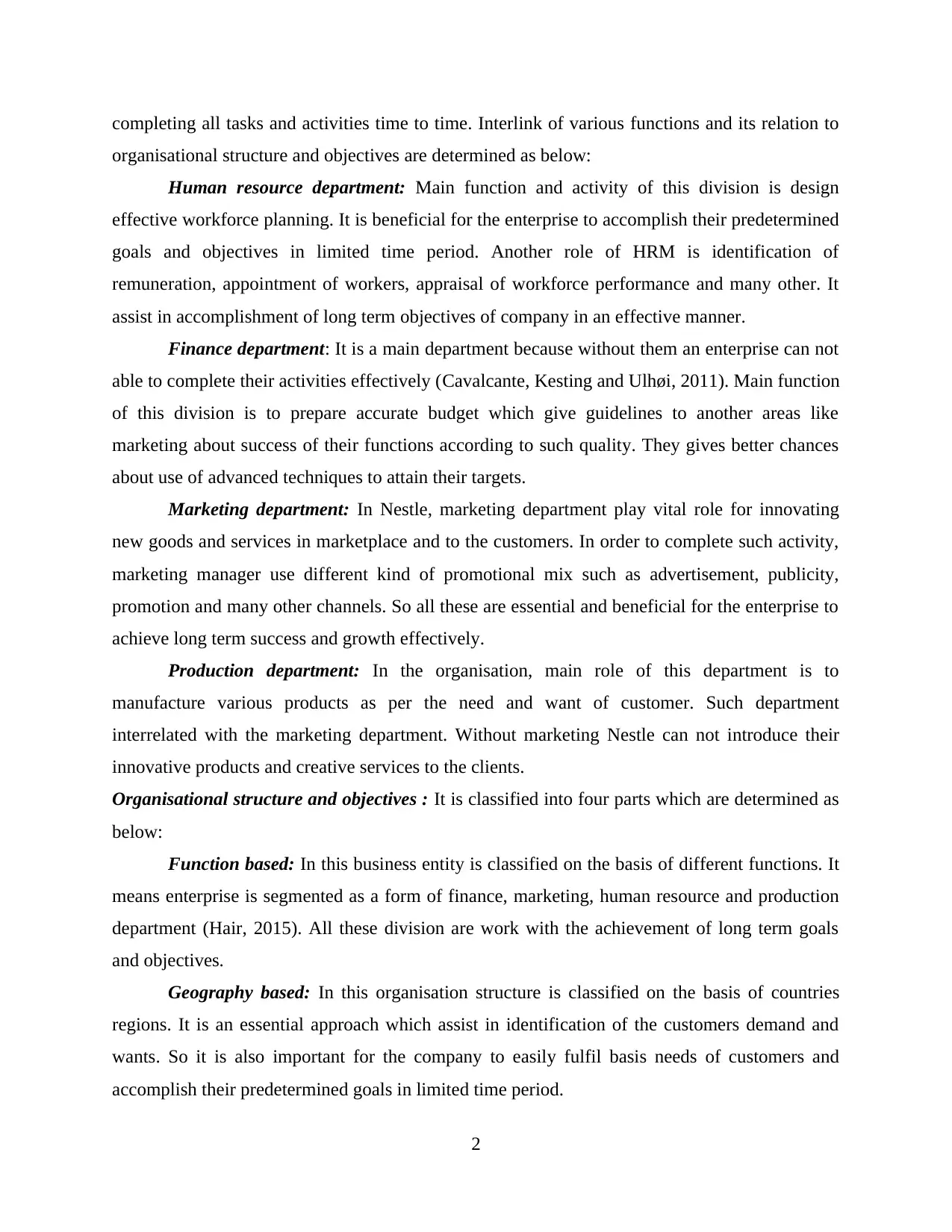
completing all tasks and activities time to time. Interlink of various functions and its relation to
organisational structure and objectives are determined as below:
Human resource department: Main function and activity of this division is design
effective workforce planning. It is beneficial for the enterprise to accomplish their predetermined
goals and objectives in limited time period. Another role of HRM is identification of
remuneration, appointment of workers, appraisal of workforce performance and many other. It
assist in accomplishment of long term objectives of company in an effective manner.
Finance department: It is a main department because without them an enterprise can not
able to complete their activities effectively (Cavalcante, Kesting and Ulhøi, 2011). Main function
of this division is to prepare accurate budget which give guidelines to another areas like
marketing about success of their functions according to such quality. They gives better chances
about use of advanced techniques to attain their targets.
Marketing department: In Nestle, marketing department play vital role for innovating
new goods and services in marketplace and to the customers. In order to complete such activity,
marketing manager use different kind of promotional mix such as advertisement, publicity,
promotion and many other channels. So all these are essential and beneficial for the enterprise to
achieve long term success and growth effectively.
Production department: In the organisation, main role of this department is to
manufacture various products as per the need and want of customer. Such department
interrelated with the marketing department. Without marketing Nestle can not introduce their
innovative products and creative services to the clients.
Organisational structure and objectives : It is classified into four parts which are determined as
below:
Function based: In this business entity is classified on the basis of different functions. It
means enterprise is segmented as a form of finance, marketing, human resource and production
department (Hair, 2015). All these division are work with the achievement of long term goals
and objectives.
Geography based: In this organisation structure is classified on the basis of countries
regions. It is an essential approach which assist in identification of the customers demand and
wants. So it is also important for the company to easily fulfil basis needs of customers and
accomplish their predetermined goals in limited time period.
2
organisational structure and objectives are determined as below:
Human resource department: Main function and activity of this division is design
effective workforce planning. It is beneficial for the enterprise to accomplish their predetermined
goals and objectives in limited time period. Another role of HRM is identification of
remuneration, appointment of workers, appraisal of workforce performance and many other. It
assist in accomplishment of long term objectives of company in an effective manner.
Finance department: It is a main department because without them an enterprise can not
able to complete their activities effectively (Cavalcante, Kesting and Ulhøi, 2011). Main function
of this division is to prepare accurate budget which give guidelines to another areas like
marketing about success of their functions according to such quality. They gives better chances
about use of advanced techniques to attain their targets.
Marketing department: In Nestle, marketing department play vital role for innovating
new goods and services in marketplace and to the customers. In order to complete such activity,
marketing manager use different kind of promotional mix such as advertisement, publicity,
promotion and many other channels. So all these are essential and beneficial for the enterprise to
achieve long term success and growth effectively.
Production department: In the organisation, main role of this department is to
manufacture various products as per the need and want of customer. Such department
interrelated with the marketing department. Without marketing Nestle can not introduce their
innovative products and creative services to the clients.
Organisational structure and objectives : It is classified into four parts which are determined as
below:
Function based: In this business entity is classified on the basis of different functions. It
means enterprise is segmented as a form of finance, marketing, human resource and production
department (Hair, 2015). All these division are work with the achievement of long term goals
and objectives.
Geography based: In this organisation structure is classified on the basis of countries
regions. It is an essential approach which assist in identification of the customers demand and
wants. So it is also important for the company to easily fulfil basis needs of customers and
accomplish their predetermined goals in limited time period.
2
Paraphrase This Document
Need a fresh take? Get an instant paraphrase of this document with our AI Paraphraser
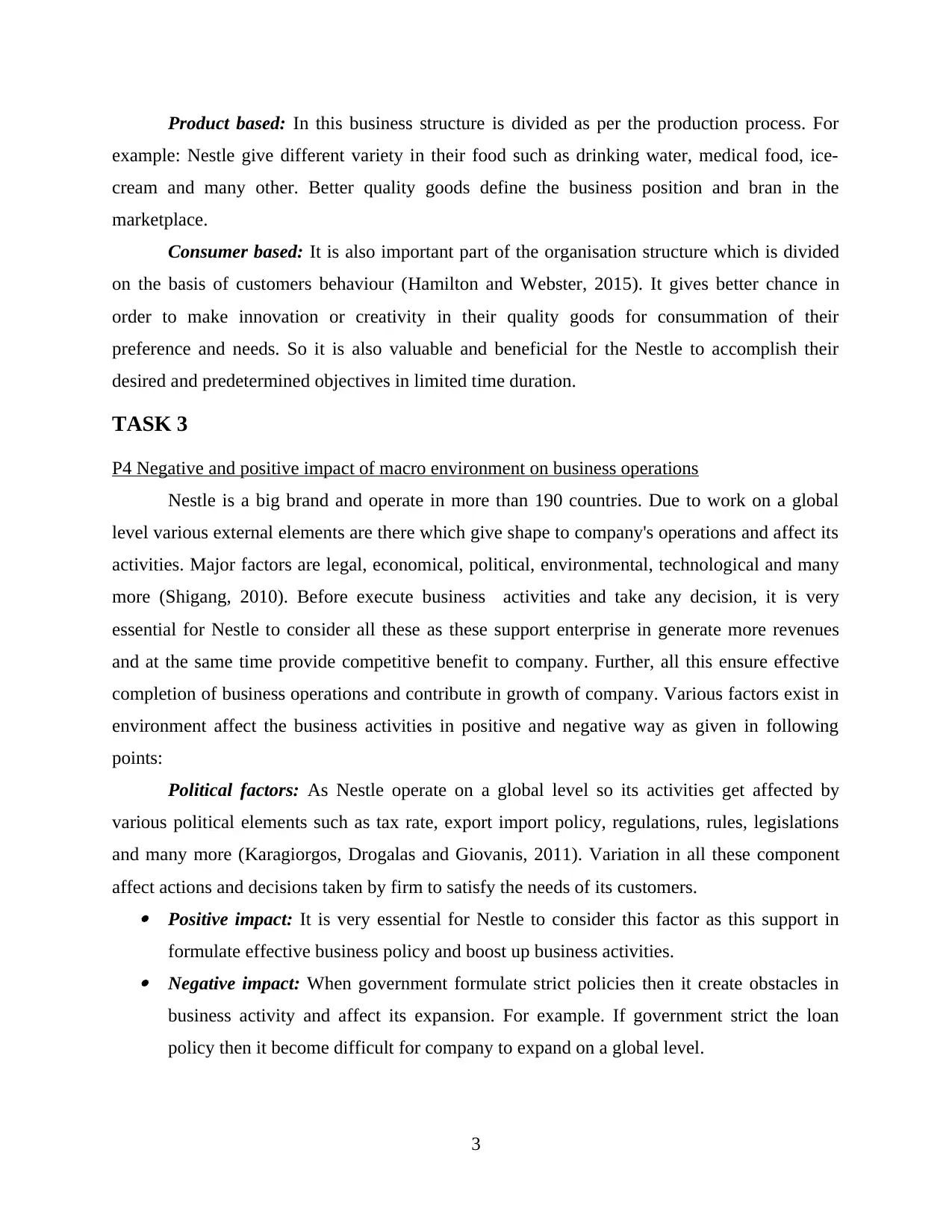
Product based: In this business structure is divided as per the production process. For
example: Nestle give different variety in their food such as drinking water, medical food, ice-
cream and many other. Better quality goods define the business position and bran in the
marketplace.
Consumer based: It is also important part of the organisation structure which is divided
on the basis of customers behaviour (Hamilton and Webster, 2015). It gives better chance in
order to make innovation or creativity in their quality goods for consummation of their
preference and needs. So it is also valuable and beneficial for the Nestle to accomplish their
desired and predetermined objectives in limited time duration.
TASK 3
P4 Negative and positive impact of macro environment on business operations
Nestle is a big brand and operate in more than 190 countries. Due to work on a global
level various external elements are there which give shape to company's operations and affect its
activities. Major factors are legal, economical, political, environmental, technological and many
more (Shigang, 2010). Before execute business activities and take any decision, it is very
essential for Nestle to consider all these as these support enterprise in generate more revenues
and at the same time provide competitive benefit to company. Further, all this ensure effective
completion of business operations and contribute in growth of company. Various factors exist in
environment affect the business activities in positive and negative way as given in following
points:
Political factors: As Nestle operate on a global level so its activities get affected by
various political elements such as tax rate, export import policy, regulations, rules, legislations
and many more (Karagiorgos, Drogalas and Giovanis, 2011). Variation in all these component
affect actions and decisions taken by firm to satisfy the needs of its customers. Positive impact: It is very essential for Nestle to consider this factor as this support in
formulate effective business policy and boost up business activities. Negative impact: When government formulate strict policies then it create obstacles in
business activity and affect its expansion. For example. If government strict the loan
policy then it become difficult for company to expand on a global level.
3
example: Nestle give different variety in their food such as drinking water, medical food, ice-
cream and many other. Better quality goods define the business position and bran in the
marketplace.
Consumer based: It is also important part of the organisation structure which is divided
on the basis of customers behaviour (Hamilton and Webster, 2015). It gives better chance in
order to make innovation or creativity in their quality goods for consummation of their
preference and needs. So it is also valuable and beneficial for the Nestle to accomplish their
desired and predetermined objectives in limited time duration.
TASK 3
P4 Negative and positive impact of macro environment on business operations
Nestle is a big brand and operate in more than 190 countries. Due to work on a global
level various external elements are there which give shape to company's operations and affect its
activities. Major factors are legal, economical, political, environmental, technological and many
more (Shigang, 2010). Before execute business activities and take any decision, it is very
essential for Nestle to consider all these as these support enterprise in generate more revenues
and at the same time provide competitive benefit to company. Further, all this ensure effective
completion of business operations and contribute in growth of company. Various factors exist in
environment affect the business activities in positive and negative way as given in following
points:
Political factors: As Nestle operate on a global level so its activities get affected by
various political elements such as tax rate, export import policy, regulations, rules, legislations
and many more (Karagiorgos, Drogalas and Giovanis, 2011). Variation in all these component
affect actions and decisions taken by firm to satisfy the needs of its customers. Positive impact: It is very essential for Nestle to consider this factor as this support in
formulate effective business policy and boost up business activities. Negative impact: When government formulate strict policies then it create obstacles in
business activity and affect its expansion. For example. If government strict the loan
policy then it become difficult for company to expand on a global level.
3
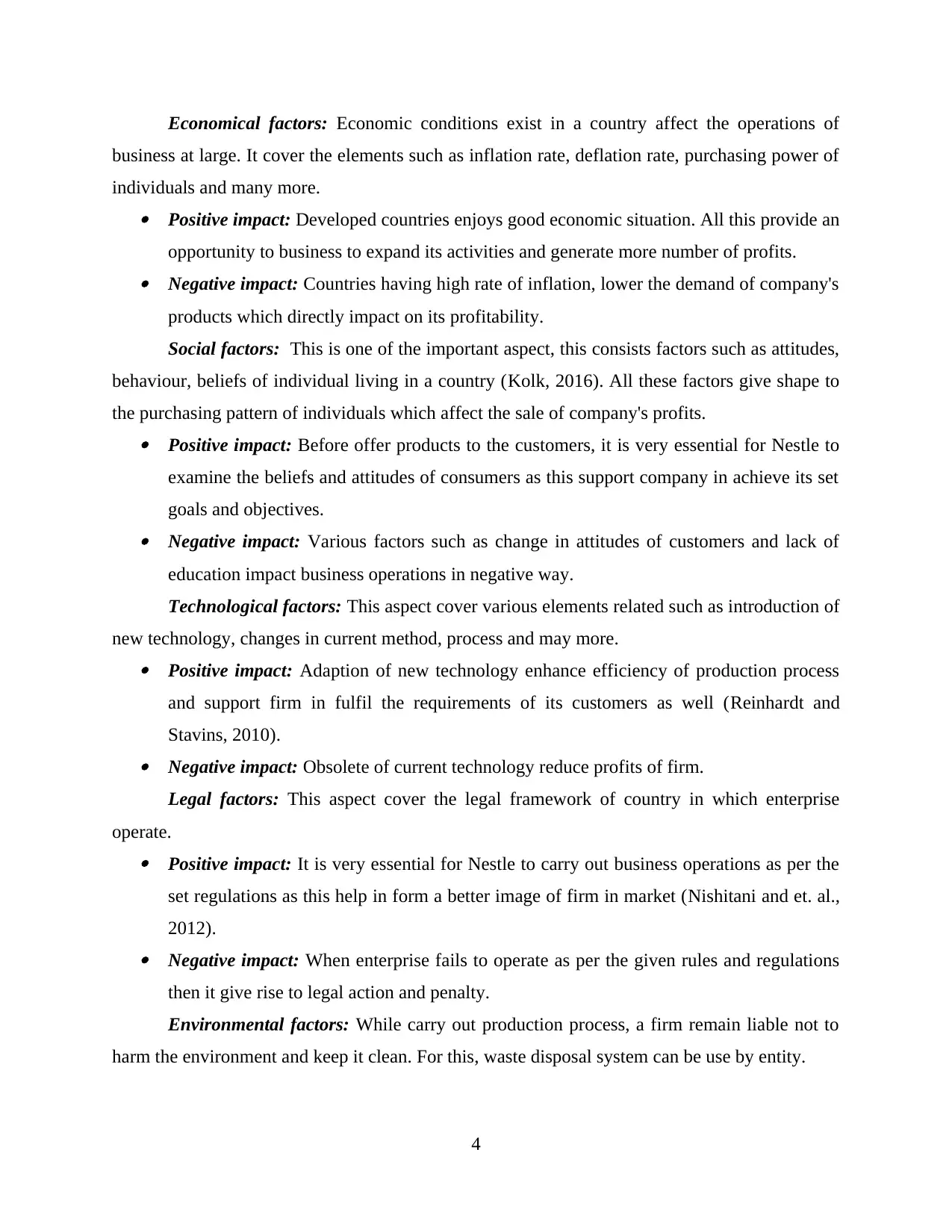
Economical factors: Economic conditions exist in a country affect the operations of
business at large. It cover the elements such as inflation rate, deflation rate, purchasing power of
individuals and many more. Positive impact: Developed countries enjoys good economic situation. All this provide an
opportunity to business to expand its activities and generate more number of profits. Negative impact: Countries having high rate of inflation, lower the demand of company's
products which directly impact on its profitability.
Social factors: This is one of the important aspect, this consists factors such as attitudes,
behaviour, beliefs of individual living in a country (Kolk, 2016). All these factors give shape to
the purchasing pattern of individuals which affect the sale of company's profits. Positive impact: Before offer products to the customers, it is very essential for Nestle to
examine the beliefs and attitudes of consumers as this support company in achieve its set
goals and objectives. Negative impact: Various factors such as change in attitudes of customers and lack of
education impact business operations in negative way.
Technological factors: This aspect cover various elements related such as introduction of
new technology, changes in current method, process and may more. Positive impact: Adaption of new technology enhance efficiency of production process
and support firm in fulfil the requirements of its customers as well (Reinhardt and
Stavins, 2010). Negative impact: Obsolete of current technology reduce profits of firm.
Legal factors: This aspect cover the legal framework of country in which enterprise
operate. Positive impact: It is very essential for Nestle to carry out business operations as per the
set regulations as this help in form a better image of firm in market (Nishitani and et. al.,
2012). Negative impact: When enterprise fails to operate as per the given rules and regulations
then it give rise to legal action and penalty.
Environmental factors: While carry out production process, a firm remain liable not to
harm the environment and keep it clean. For this, waste disposal system can be use by entity.
4
business at large. It cover the elements such as inflation rate, deflation rate, purchasing power of
individuals and many more. Positive impact: Developed countries enjoys good economic situation. All this provide an
opportunity to business to expand its activities and generate more number of profits. Negative impact: Countries having high rate of inflation, lower the demand of company's
products which directly impact on its profitability.
Social factors: This is one of the important aspect, this consists factors such as attitudes,
behaviour, beliefs of individual living in a country (Kolk, 2016). All these factors give shape to
the purchasing pattern of individuals which affect the sale of company's profits. Positive impact: Before offer products to the customers, it is very essential for Nestle to
examine the beliefs and attitudes of consumers as this support company in achieve its set
goals and objectives. Negative impact: Various factors such as change in attitudes of customers and lack of
education impact business operations in negative way.
Technological factors: This aspect cover various elements related such as introduction of
new technology, changes in current method, process and may more. Positive impact: Adaption of new technology enhance efficiency of production process
and support firm in fulfil the requirements of its customers as well (Reinhardt and
Stavins, 2010). Negative impact: Obsolete of current technology reduce profits of firm.
Legal factors: This aspect cover the legal framework of country in which enterprise
operate. Positive impact: It is very essential for Nestle to carry out business operations as per the
set regulations as this help in form a better image of firm in market (Nishitani and et. al.,
2012). Negative impact: When enterprise fails to operate as per the given rules and regulations
then it give rise to legal action and penalty.
Environmental factors: While carry out production process, a firm remain liable not to
harm the environment and keep it clean. For this, waste disposal system can be use by entity.
4
⊘ This is a preview!⊘
Do you want full access?
Subscribe today to unlock all pages.

Trusted by 1+ million students worldwide
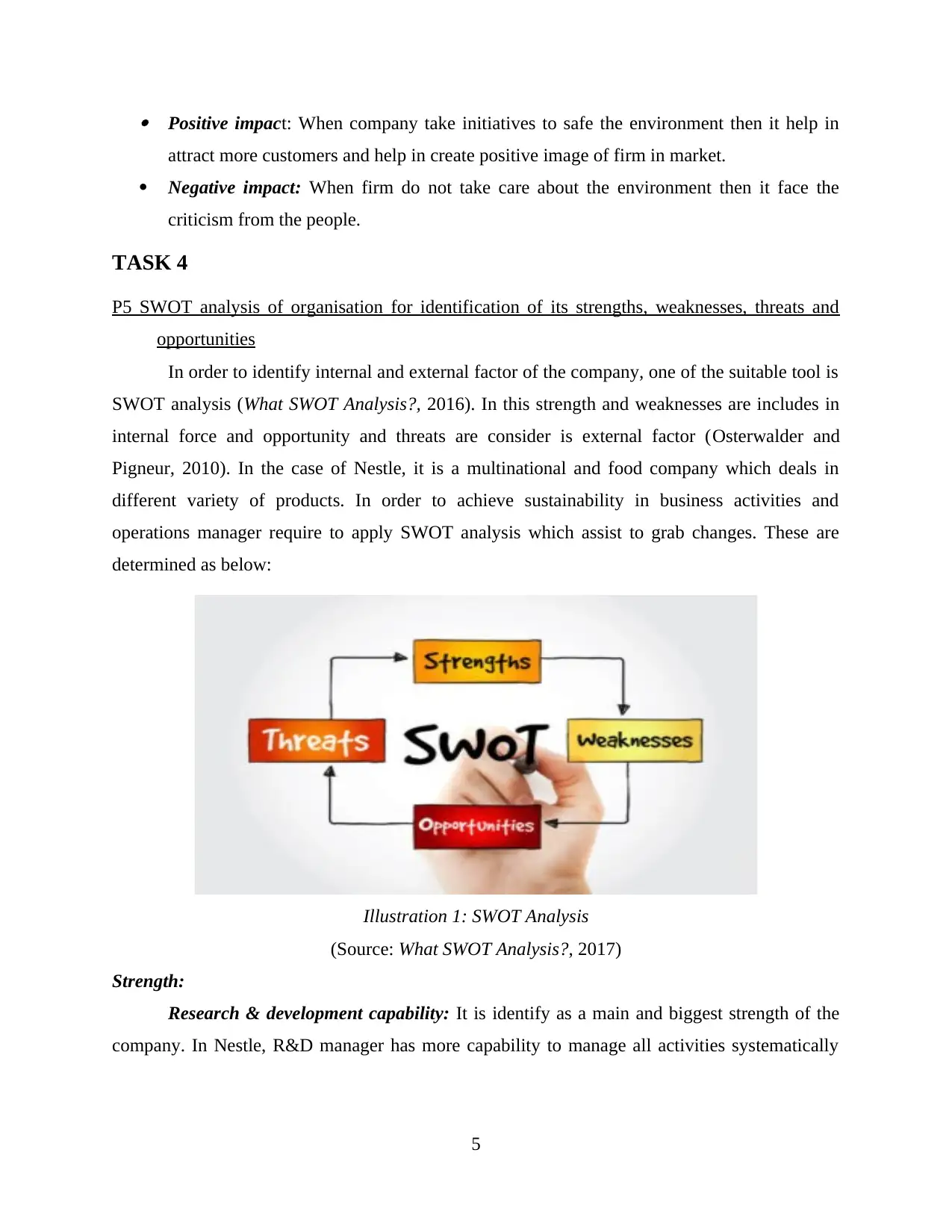
Positive impact: When company take initiatives to safe the environment then it help in
attract more customers and help in create positive image of firm in market.
Negative impact: When firm do not take care about the environment then it face the
criticism from the people.
TASK 4
P5 SWOT analysis of organisation for identification of its strengths, weaknesses, threats and
opportunities
In order to identify internal and external factor of the company, one of the suitable tool is
SWOT analysis (What SWOT Analysis?, 2016). In this strength and weaknesses are includes in
internal force and opportunity and threats are consider is external factor (Osterwalder and
Pigneur, 2010). In the case of Nestle, it is a multinational and food company which deals in
different variety of products. In order to achieve sustainability in business activities and
operations manager require to apply SWOT analysis which assist to grab changes. These are
determined as below:
Illustration 1: SWOT Analysis
(Source: What SWOT Analysis?, 2017)
Strength:
Research & development capability: It is identify as a main and biggest strength of the
company. In Nestle, R&D manager has more capability to manage all activities systematically
5
attract more customers and help in create positive image of firm in market.
Negative impact: When firm do not take care about the environment then it face the
criticism from the people.
TASK 4
P5 SWOT analysis of organisation for identification of its strengths, weaknesses, threats and
opportunities
In order to identify internal and external factor of the company, one of the suitable tool is
SWOT analysis (What SWOT Analysis?, 2016). In this strength and weaknesses are includes in
internal force and opportunity and threats are consider is external factor (Osterwalder and
Pigneur, 2010). In the case of Nestle, it is a multinational and food company which deals in
different variety of products. In order to achieve sustainability in business activities and
operations manager require to apply SWOT analysis which assist to grab changes. These are
determined as below:
Illustration 1: SWOT Analysis
(Source: What SWOT Analysis?, 2017)
Strength:
Research & development capability: It is identify as a main and biggest strength of the
company. In Nestle, R&D manager has more capability to manage all activities systematically
5
Paraphrase This Document
Need a fresh take? Get an instant paraphrase of this document with our AI Paraphraser
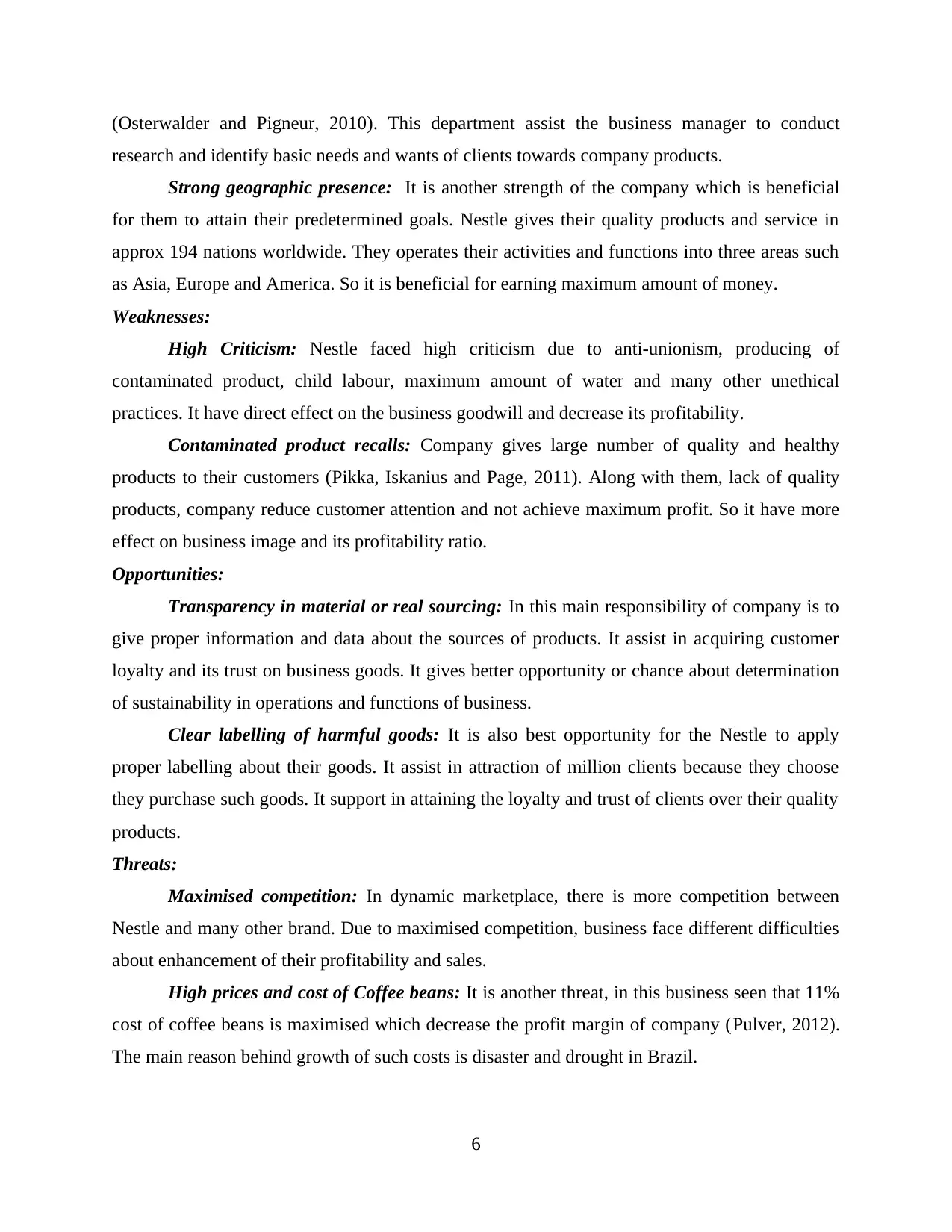
(Osterwalder and Pigneur, 2010). This department assist the business manager to conduct
research and identify basic needs and wants of clients towards company products.
Strong geographic presence: It is another strength of the company which is beneficial
for them to attain their predetermined goals. Nestle gives their quality products and service in
approx 194 nations worldwide. They operates their activities and functions into three areas such
as Asia, Europe and America. So it is beneficial for earning maximum amount of money.
Weaknesses:
High Criticism: Nestle faced high criticism due to anti-unionism, producing of
contaminated product, child labour, maximum amount of water and many other unethical
practices. It have direct effect on the business goodwill and decrease its profitability.
Contaminated product recalls: Company gives large number of quality and healthy
products to their customers (Pikka, Iskanius and Page, 2011). Along with them, lack of quality
products, company reduce customer attention and not achieve maximum profit. So it have more
effect on business image and its profitability ratio.
Opportunities:
Transparency in material or real sourcing: In this main responsibility of company is to
give proper information and data about the sources of products. It assist in acquiring customer
loyalty and its trust on business goods. It gives better opportunity or chance about determination
of sustainability in operations and functions of business.
Clear labelling of harmful goods: It is also best opportunity for the Nestle to apply
proper labelling about their goods. It assist in attraction of million clients because they choose
they purchase such goods. It support in attaining the loyalty and trust of clients over their quality
products.
Threats:
Maximised competition: In dynamic marketplace, there is more competition between
Nestle and many other brand. Due to maximised competition, business face different difficulties
about enhancement of their profitability and sales.
High prices and cost of Coffee beans: It is another threat, in this business seen that 11%
cost of coffee beans is maximised which decrease the profit margin of company (Pulver, 2012).
The main reason behind growth of such costs is disaster and drought in Brazil.
6
research and identify basic needs and wants of clients towards company products.
Strong geographic presence: It is another strength of the company which is beneficial
for them to attain their predetermined goals. Nestle gives their quality products and service in
approx 194 nations worldwide. They operates their activities and functions into three areas such
as Asia, Europe and America. So it is beneficial for earning maximum amount of money.
Weaknesses:
High Criticism: Nestle faced high criticism due to anti-unionism, producing of
contaminated product, child labour, maximum amount of water and many other unethical
practices. It have direct effect on the business goodwill and decrease its profitability.
Contaminated product recalls: Company gives large number of quality and healthy
products to their customers (Pikka, Iskanius and Page, 2011). Along with them, lack of quality
products, company reduce customer attention and not achieve maximum profit. So it have more
effect on business image and its profitability ratio.
Opportunities:
Transparency in material or real sourcing: In this main responsibility of company is to
give proper information and data about the sources of products. It assist in acquiring customer
loyalty and its trust on business goods. It gives better opportunity or chance about determination
of sustainability in operations and functions of business.
Clear labelling of harmful goods: It is also best opportunity for the Nestle to apply
proper labelling about their goods. It assist in attraction of million clients because they choose
they purchase such goods. It support in attaining the loyalty and trust of clients over their quality
products.
Threats:
Maximised competition: In dynamic marketplace, there is more competition between
Nestle and many other brand. Due to maximised competition, business face different difficulties
about enhancement of their profitability and sales.
High prices and cost of Coffee beans: It is another threat, in this business seen that 11%
cost of coffee beans is maximised which decrease the profit margin of company (Pulver, 2012).
The main reason behind growth of such costs is disaster and drought in Brazil.
6
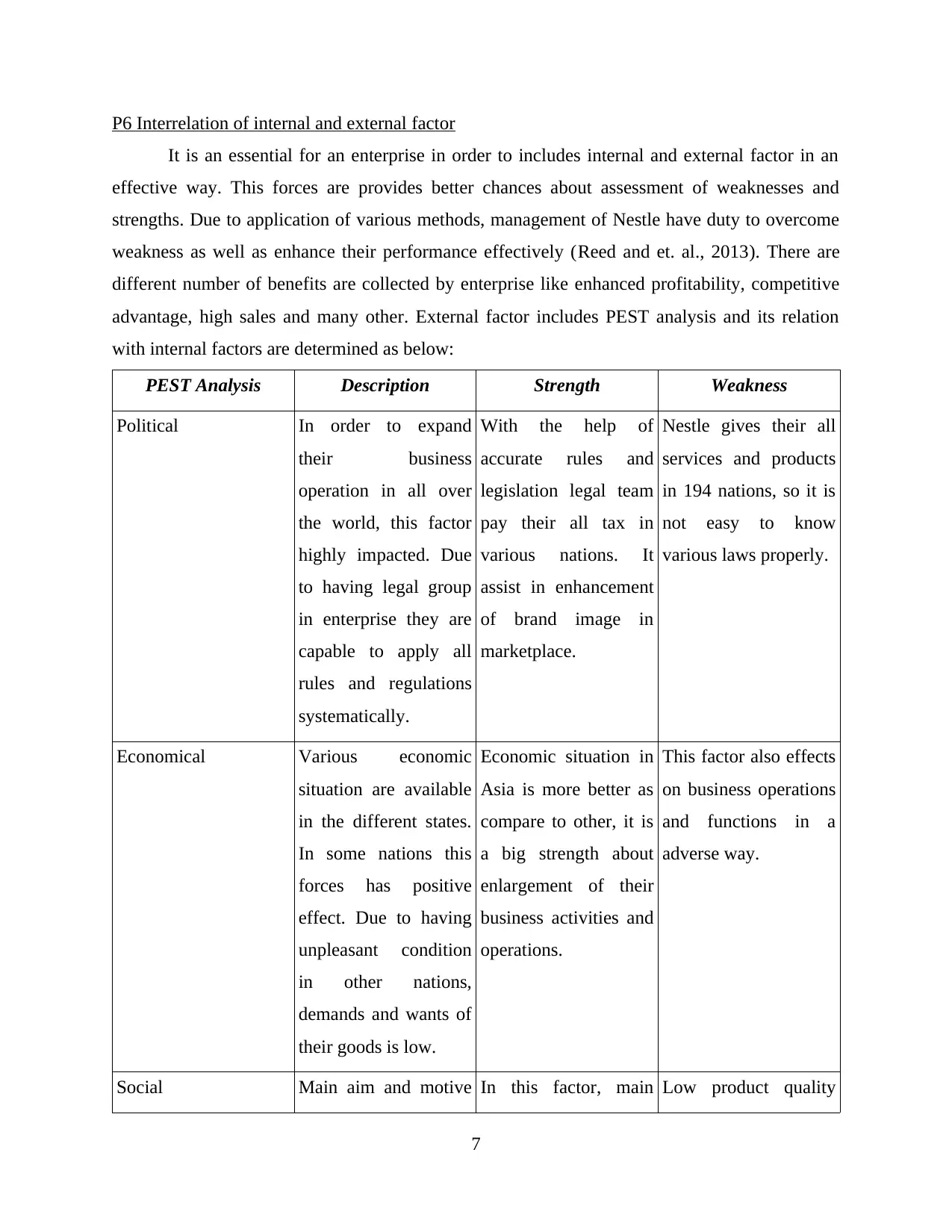
P6 Interrelation of internal and external factor
It is an essential for an enterprise in order to includes internal and external factor in an
effective way. This forces are provides better chances about assessment of weaknesses and
strengths. Due to application of various methods, management of Nestle have duty to overcome
weakness as well as enhance their performance effectively (Reed and et. al., 2013). There are
different number of benefits are collected by enterprise like enhanced profitability, competitive
advantage, high sales and many other. External factor includes PEST analysis and its relation
with internal factors are determined as below:
PEST Analysis Description Strength Weakness
Political In order to expand
their business
operation in all over
the world, this factor
highly impacted. Due
to having legal group
in enterprise they are
capable to apply all
rules and regulations
systematically.
With the help of
accurate rules and
legislation legal team
pay their all tax in
various nations. It
assist in enhancement
of brand image in
marketplace.
Nestle gives their all
services and products
in 194 nations, so it is
not easy to know
various laws properly.
Economical Various economic
situation are available
in the different states.
In some nations this
forces has positive
effect. Due to having
unpleasant condition
in other nations,
demands and wants of
their goods is low.
Economic situation in
Asia is more better as
compare to other, it is
a big strength about
enlargement of their
business activities and
operations.
This factor also effects
on business operations
and functions in a
adverse way.
Social Main aim and motive In this factor, main Low product quality
7
It is an essential for an enterprise in order to includes internal and external factor in an
effective way. This forces are provides better chances about assessment of weaknesses and
strengths. Due to application of various methods, management of Nestle have duty to overcome
weakness as well as enhance their performance effectively (Reed and et. al., 2013). There are
different number of benefits are collected by enterprise like enhanced profitability, competitive
advantage, high sales and many other. External factor includes PEST analysis and its relation
with internal factors are determined as below:
PEST Analysis Description Strength Weakness
Political In order to expand
their business
operation in all over
the world, this factor
highly impacted. Due
to having legal group
in enterprise they are
capable to apply all
rules and regulations
systematically.
With the help of
accurate rules and
legislation legal team
pay their all tax in
various nations. It
assist in enhancement
of brand image in
marketplace.
Nestle gives their all
services and products
in 194 nations, so it is
not easy to know
various laws properly.
Economical Various economic
situation are available
in the different states.
In some nations this
forces has positive
effect. Due to having
unpleasant condition
in other nations,
demands and wants of
their goods is low.
Economic situation in
Asia is more better as
compare to other, it is
a big strength about
enlargement of their
business activities and
operations.
This factor also effects
on business operations
and functions in a
adverse way.
Social Main aim and motive In this factor, main Low product quality
7
⊘ This is a preview!⊘
Do you want full access?
Subscribe today to unlock all pages.

Trusted by 1+ million students worldwide
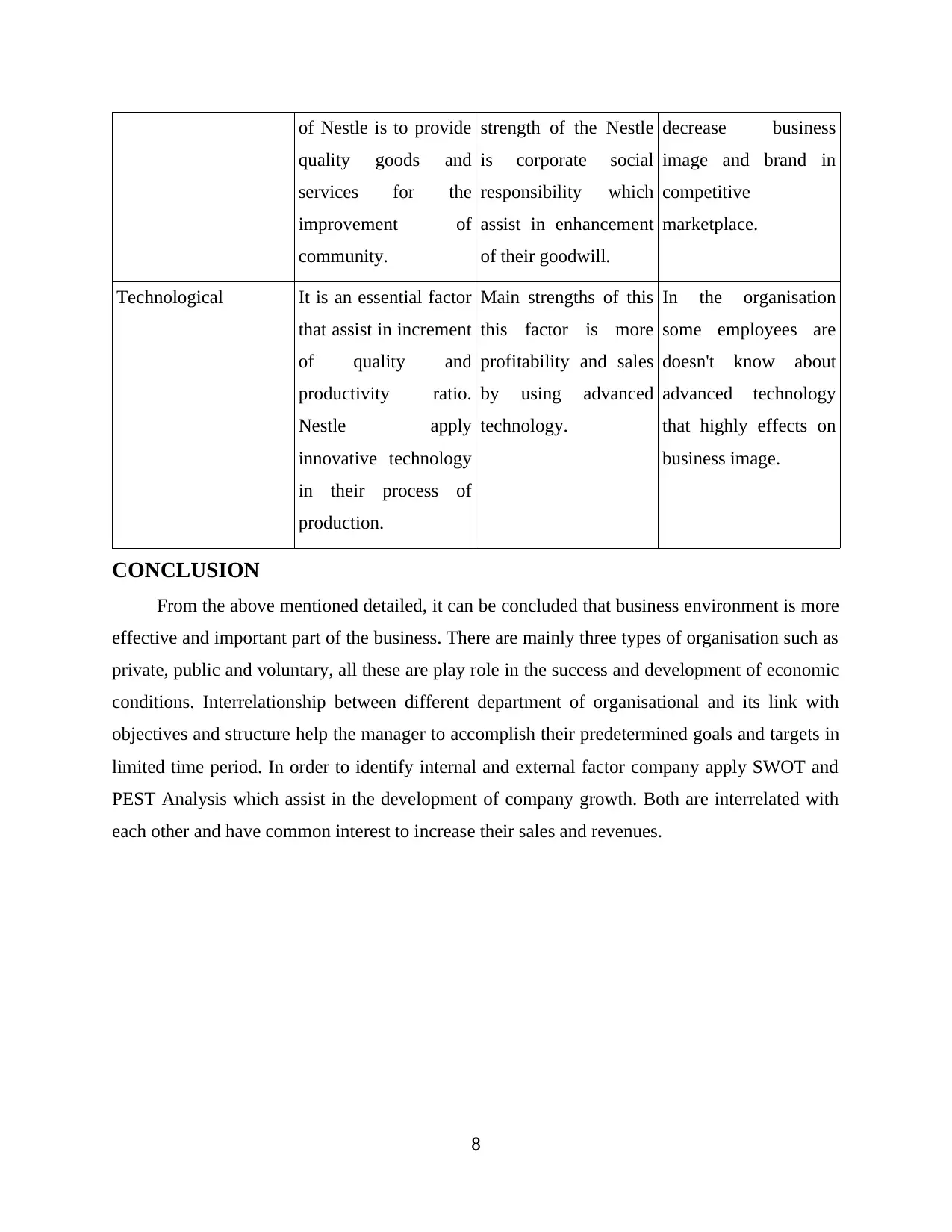
of Nestle is to provide
quality goods and
services for the
improvement of
community.
strength of the Nestle
is corporate social
responsibility which
assist in enhancement
of their goodwill.
decrease business
image and brand in
competitive
marketplace.
Technological It is an essential factor
that assist in increment
of quality and
productivity ratio.
Nestle apply
innovative technology
in their process of
production.
Main strengths of this
this factor is more
profitability and sales
by using advanced
technology.
In the organisation
some employees are
doesn't know about
advanced technology
that highly effects on
business image.
CONCLUSION
From the above mentioned detailed, it can be concluded that business environment is more
effective and important part of the business. There are mainly three types of organisation such as
private, public and voluntary, all these are play role in the success and development of economic
conditions. Interrelationship between different department of organisational and its link with
objectives and structure help the manager to accomplish their predetermined goals and targets in
limited time period. In order to identify internal and external factor company apply SWOT and
PEST Analysis which assist in the development of company growth. Both are interrelated with
each other and have common interest to increase their sales and revenues.
8
quality goods and
services for the
improvement of
community.
strength of the Nestle
is corporate social
responsibility which
assist in enhancement
of their goodwill.
decrease business
image and brand in
competitive
marketplace.
Technological It is an essential factor
that assist in increment
of quality and
productivity ratio.
Nestle apply
innovative technology
in their process of
production.
Main strengths of this
this factor is more
profitability and sales
by using advanced
technology.
In the organisation
some employees are
doesn't know about
advanced technology
that highly effects on
business image.
CONCLUSION
From the above mentioned detailed, it can be concluded that business environment is more
effective and important part of the business. There are mainly three types of organisation such as
private, public and voluntary, all these are play role in the success and development of economic
conditions. Interrelationship between different department of organisational and its link with
objectives and structure help the manager to accomplish their predetermined goals and targets in
limited time period. In order to identify internal and external factor company apply SWOT and
PEST Analysis which assist in the development of company growth. Both are interrelated with
each other and have common interest to increase their sales and revenues.
8
Paraphrase This Document
Need a fresh take? Get an instant paraphrase of this document with our AI Paraphraser
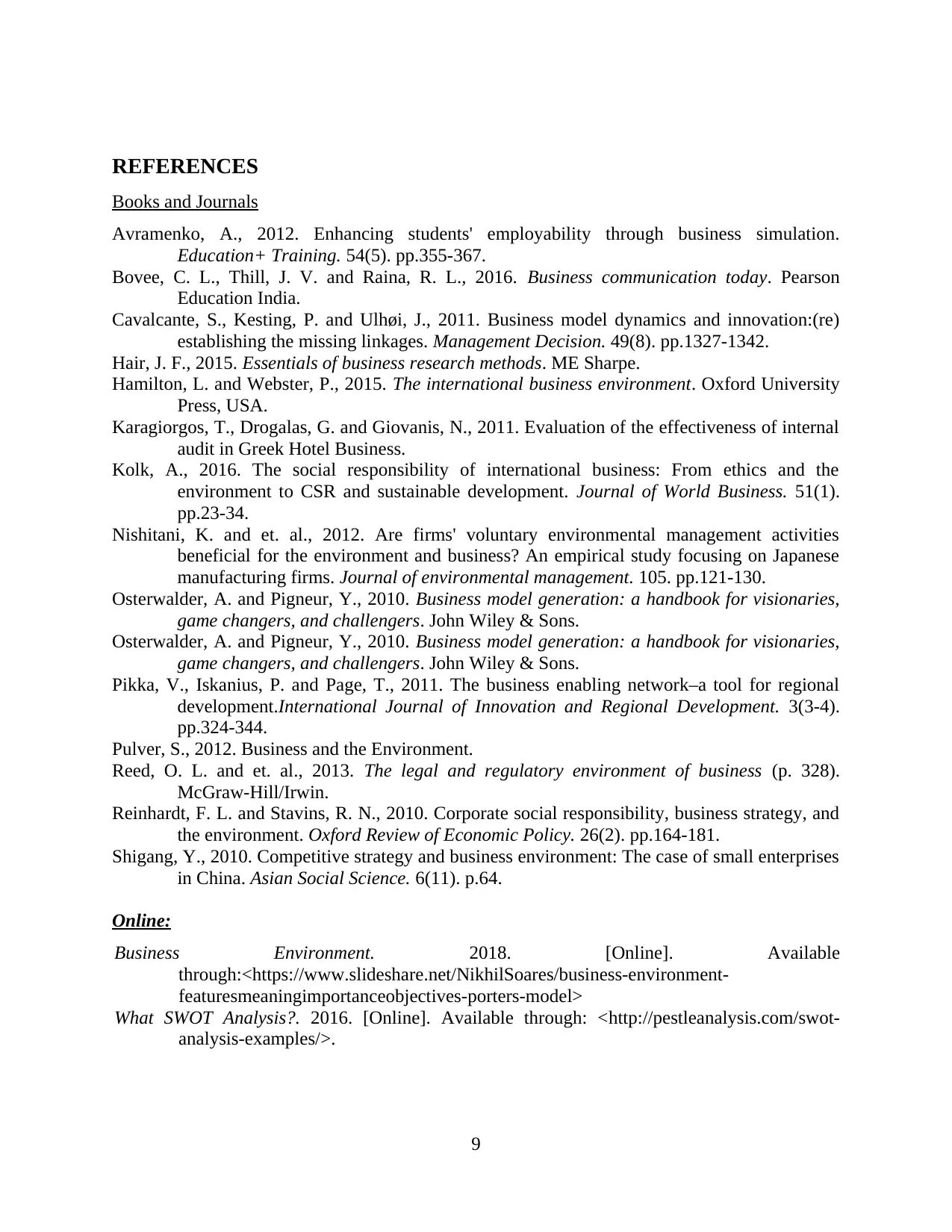
REFERENCES
Books and Journals
Avramenko, A., 2012. Enhancing students' employability through business simulation.
Education+ Training. 54(5). pp.355-367.
Bovee, C. L., Thill, J. V. and Raina, R. L., 2016. Business communication today. Pearson
Education India.
Cavalcante, S., Kesting, P. and Ulhøi, J., 2011. Business model dynamics and innovation:(re)
establishing the missing linkages. Management Decision. 49(8). pp.1327-1342.
Hair, J. F., 2015. Essentials of business research methods. ME Sharpe.
Hamilton, L. and Webster, P., 2015. The international business environment. Oxford University
Press, USA.
Karagiorgos, T., Drogalas, G. and Giovanis, N., 2011. Evaluation of the effectiveness of internal
audit in Greek Hotel Business.
Kolk, A., 2016. The social responsibility of international business: From ethics and the
environment to CSR and sustainable development. Journal of World Business. 51(1).
pp.23-34.
Nishitani, K. and et. al., 2012. Are firms' voluntary environmental management activities
beneficial for the environment and business? An empirical study focusing on Japanese
manufacturing firms. Journal of environmental management. 105. pp.121-130.
Osterwalder, A. and Pigneur, Y., 2010. Business model generation: a handbook for visionaries,
game changers, and challengers. John Wiley & Sons.
Osterwalder, A. and Pigneur, Y., 2010. Business model generation: a handbook for visionaries,
game changers, and challengers. John Wiley & Sons.
Pikka, V., Iskanius, P. and Page, T., 2011. The business enabling network–a tool for regional
development.International Journal of Innovation and Regional Development. 3(3-4).
pp.324-344.
Pulver, S., 2012. Business and the Environment.
Reed, O. L. and et. al., 2013. The legal and regulatory environment of business (p. 328).
McGraw-Hill/Irwin.
Reinhardt, F. L. and Stavins, R. N., 2010. Corporate social responsibility, business strategy, and
the environment. Oxford Review of Economic Policy. 26(2). pp.164-181.
Shigang, Y., 2010. Competitive strategy and business environment: The case of small enterprises
in China. Asian Social Science. 6(11). p.64.
Online:
Business Environment. 2018. [Online]. Available
through:<https://www.slideshare.net/NikhilSoares/business-environment-
featuresmeaningimportanceobjectives-porters-model>
What SWOT Analysis?. 2016. [Online]. Available through: <http://pestleanalysis.com/swot-
analysis-examples/>.
9
Books and Journals
Avramenko, A., 2012. Enhancing students' employability through business simulation.
Education+ Training. 54(5). pp.355-367.
Bovee, C. L., Thill, J. V. and Raina, R. L., 2016. Business communication today. Pearson
Education India.
Cavalcante, S., Kesting, P. and Ulhøi, J., 2011. Business model dynamics and innovation:(re)
establishing the missing linkages. Management Decision. 49(8). pp.1327-1342.
Hair, J. F., 2015. Essentials of business research methods. ME Sharpe.
Hamilton, L. and Webster, P., 2015. The international business environment. Oxford University
Press, USA.
Karagiorgos, T., Drogalas, G. and Giovanis, N., 2011. Evaluation of the effectiveness of internal
audit in Greek Hotel Business.
Kolk, A., 2016. The social responsibility of international business: From ethics and the
environment to CSR and sustainable development. Journal of World Business. 51(1).
pp.23-34.
Nishitani, K. and et. al., 2012. Are firms' voluntary environmental management activities
beneficial for the environment and business? An empirical study focusing on Japanese
manufacturing firms. Journal of environmental management. 105. pp.121-130.
Osterwalder, A. and Pigneur, Y., 2010. Business model generation: a handbook for visionaries,
game changers, and challengers. John Wiley & Sons.
Osterwalder, A. and Pigneur, Y., 2010. Business model generation: a handbook for visionaries,
game changers, and challengers. John Wiley & Sons.
Pikka, V., Iskanius, P. and Page, T., 2011. The business enabling network–a tool for regional
development.International Journal of Innovation and Regional Development. 3(3-4).
pp.324-344.
Pulver, S., 2012. Business and the Environment.
Reed, O. L. and et. al., 2013. The legal and regulatory environment of business (p. 328).
McGraw-Hill/Irwin.
Reinhardt, F. L. and Stavins, R. N., 2010. Corporate social responsibility, business strategy, and
the environment. Oxford Review of Economic Policy. 26(2). pp.164-181.
Shigang, Y., 2010. Competitive strategy and business environment: The case of small enterprises
in China. Asian Social Science. 6(11). p.64.
Online:
Business Environment. 2018. [Online]. Available
through:<https://www.slideshare.net/NikhilSoares/business-environment-
featuresmeaningimportanceobjectives-porters-model>
What SWOT Analysis?. 2016. [Online]. Available through: <http://pestleanalysis.com/swot-
analysis-examples/>.
9
1 out of 11
Related Documents
Your All-in-One AI-Powered Toolkit for Academic Success.
+13062052269
info@desklib.com
Available 24*7 on WhatsApp / Email
![[object Object]](/_next/static/media/star-bottom.7253800d.svg)
Unlock your academic potential
Copyright © 2020–2025 A2Z Services. All Rights Reserved. Developed and managed by ZUCOL.





